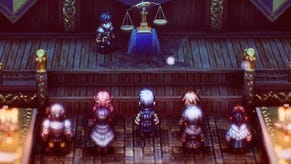Octopath Traveler: a 90s-style JPRG brought to life with cutting-edge tech
Unreal Engine 4 powers a hybrid game for a hybrid console.
The Japanese RPG has travelled a long road since the early days of sprite-based 2D adventuring, but in Octopath Traveler we have a fascinating blend of old and new. Exclusive to Switch, it takes the traditional top-down style of Super NES greats like Final Fantasy 6 and blends it with the cutting-edge 3D rendering techniques of Unreal Engine 4. It's a hybrid JRPG for a hybrid console, but developers Square Enix and Acquire know exactly where to push the boat out technically and where to stick to the tried and tested 2D template. The result is a beautiful and compelling Switch exclusive that's well worth checking out.
Fundamentally, Octopath Traveler is built on sprite-based characters - but look closer and you quickly see how extensively Unreal Engine 4's features are applied to the rest. Towns, for example, are modelled in 3D, but wrapped in pixelated textures to simulate a much older game. Each texture acts like a copy-pasted tile, as if bound by the memory budget of a 16-bit era console - even if in fact, the entire scene is built on a polygonal framework.
For replicating an older style it works brilliantly - it's certainly more ambitious than sticking with a traditional 2D design and the effort pays off with the effects it layers on top. A case in point is the game's high quality bokeh depth of field. The quality of the effect wouldn't be possible without a 3D logic running underneath - making the most of spatial depth to add a shallow focal range to each area. It's proudly exaggerated too by Square Enix, sharpening the frame at the screen's centre, while distorting specular points towards the back and foreground. Unreal Engine 4 brings plenty to the table, but this is perhaps the most eye-catching part of the old-meets-new experiment. It also has an unusual side-effect on the game's sense of scale - mimicking a tilt-shift photographical style, making everything look like a miniature model.
It doesn't end there. Complex shader-work is built into the level design - for ice and stonework, for example - adding a beautiful, specular component as you walk through towns. They're more advanced by design than the rest of the package, but crucially, they only flatter the 2D character sprites running over the top. Even water is rendered using a proper animated shader, adding accurate reflections of nearby light. Another welcome detail is the use of full cloth simulation on flags, deceptively disguised as an old low-resolution texture. Again, this unusual mixture of elements goes far beyond the scope of systems in the 90s, but that classic style never feels overwhelmed by it.
A huge benefit to relying on these 3D environments, high-grade shaders and physics is that it all interacts properly with light. Carrying torches around a level causes light to bounce logically on nearby objects, and separate rays flood a church to create a gorgeous specular fizz across the ground. Another smart detail is the way shadows are rendered. Despite our heroes being purely sprite-based, they're assigned a physical value in this 3D space to let them cast shade. For a low-cast sun streaming through the window, it means characters cast a long silhouette across the ground. Outdoors it's the same deal; characters don't just have a dark circle underfoot - these are proper perspective-correct shadows that apply universally.
Another great touch is the cloud simulation, causing blankets of shade to roll across the terrain, and changing the intensity of each shadow. Along with the mist, snow, and light shaft effects, it beds everything into the scene wonderfully, and at times, it's easy to lose track of which parts of a scene are truly 2D. Equally for battles, casting spells and racking up boost points changes the environment's hue. Fire and smoke effects use high resolution alpha - no call-backs to the 16-bit days here. Better still, they brighten up the entire room, flashing the area with light just as you'd expect from a modern day title.
The visuals are striking but the game's sound design deserves major credit too. Rather than using a faux-retro soundtrack, the team pushes the boat out with a mixture of beautifully composed classical and Celtic tracks. These weave between high-quality samples and live instruments, creating a soundtrack evocative of the SNES era, though instruments are delivered at a far higher quality level. Voice acting is included too for key scenes, but sadly, dialogue in-between unfolds with only the occasional sound bite. Another missed opportunity is the presentation of its major narrative beats, and cutscenes simply aren't as extravagant as the genre's heavyweights. Don't expect big budget pre-rendered videos here: most of the story tends to play out in dialogue boxes.
All of this goes way beyond the scope of a traditional JRPG - but there is a cost. Simply creating a 2D title on Switch would have been a far simpler endeavour, but it would have robbed Octopath Traveler of its signature, hybrid visual style. With that in mind, the resolution has to drop to suit the ambition, with pixel-count topping out at 720p while docked. Even if you have the console set to 1080p, the text and UI elements also scale up from 720p, which is unfortunate. On the other hand, if you're using the Switch purely as a handheld, you get all the same effects as docked play, but it simply runs at a lower resolution of 1024x576. In that case, the UI stays fixed at 720p at least, and so these elements look sharp, pixel-mapped to Switch's smaller display.
But what about performance? Well, whether it's docked or portable, expect a 30fps cap here, which is thankfully locked with no signs of drops from our testing so far. The only small issue in this case is the presence of frame-pacing issues. You can face entire passages of play without any trouble, but in battle especially, that frame-time line can trill constantly between 16, 33 and 50ms. Fortunately, camera motion tends to be fairly static in combat anyway, which minimises the perceivable effect of it at its peak. In travelling towns and dungeons, that frame-pacing quirk is there but thankfully it manifests less frequently. All things considered, it's not 100 per cent perfect, but it doesn't detract too greatly from what's otherwise a beautifully presented game.
Ultimately, Square Enix deserves kudos for trying something new - something adventurous. We've seen its teams of developers use Unreal Engine 4 for plenty of its projects this generation, including the likes of Dragon Quest 11 and Kingdom Hearts 3. The budget and brief for Octopath Traveler is clearly on an entirely different level, but smaller projects like this give the company a rare, but necessary chance to experiment - to revisit older ideas and try to reinvent them. In this case it works: the concept is brilliant - and it succeeds in framing the golden era of JRPGs through a modern lens, backed by one of the most advanced engines on the market. If you're a JRPG fan or simply want to see a Switch title doing something a little different, this is well worth checking out.











